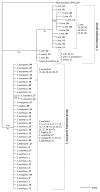Apomictic Mountain Whitebeam (Sorbus austriaca, Rosaceae) Comprises Several Genetically and Morphologically Divergent Lineages
- PMID: 36979072
- PMCID: PMC10045669
- DOI: 10.3390/biology12030380
Apomictic Mountain Whitebeam (Sorbus austriaca, Rosaceae) Comprises Several Genetically and Morphologically Divergent Lineages
Abstract
The interplay of polyploidisation, hybridization, and apomixis contributed to the exceptional diversity of Sorbus (Rosaceae), giving rise to a mosaic of genetic and morphological entities. The Sorbus austriaca species complex from the mountains of Central and South-eastern Europe represents an allopolyploid apomictic system of populations that originated following hybridisation between S. aria and S. aucuparia. However, the mode and frequency of such allopolyploidisations and the relationships among different, morphologically more or less similar populations that have often been described as different taxa remain largely unexplored. We used amplified fragment length polymorphism (AFLP) fingerprinting, plastid DNA sequencing, and analyses of nuclear microsatellites, along with multivariate morphometrics and ploidy data, to disentangle the relationships among populations within this intricate complex. Our results revealed a mosaic of genetic lineages-many of which have not been taxonomically recognised-that originated via multiple allopolyploidisations. The clonal structure within and among populations was then maintained via apomixis. Our results thus support previous findings that hybridisation, polyploidization, and apomixis are the main drivers of Sorbus diversification in Europe.
Keywords: Sorbus austriaca; apomixis; hybridisation; multiple origins; polyploidy.
Conflict of interest statement
The authors declare no conflict of interest.
Figures





References
Grants and funding
LinkOut - more resources
Full Text Sources

